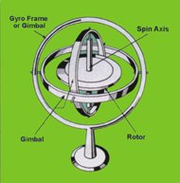Gyroscope
|
|
Velo_acrobatique_2.jpg
A gyroscope is a device which demonstrates the principle of conservation of angular momentum, in physics this is also known as gyroscopic inertia or rigidity in space.
The essence of the device is a spinning wheel on an axle. The device, once spinning, tends to resist changes to its orientation (the property of inertia). The gyroscope was invented and named in 1852 by Léon Foucault for an experiment involving the rotation of the Earth.
A gyroscope exhibits a number of behaviours including precession and nutation. Gyroscopes can be used to construct gyrocompasses which complement or replace magnetic compasses (in ships, aircraft and spacecraft, vehicles in general), to assist in stability (bicycle, Hubble Space Telescope, ships, vehicles in general) or be used as part of an Inertial guidance system. Gyroscopic effects are used in toys like yo-yos and dynabees. Many other rotating devices, such as flywheels, behave gyroscopically although the gyroscopic effect is not used.
The fundamental equation describing the behaviour of the gyroscope is:
- <math>\mathbf{\tau}={{d \mathbf{L}}\over {dt}}={{d(I\mathbf{\omega})} \over {dt}}=I\mathbf{\alpha}<math>
where the vectors τ and L are, respectively, the torque on the gyroscope and its angular momentum, the scalar I is its moment of inertia, the vector ω is its angular velocity, and the vector α is its angular acceleration.
It follows from this that a torque τ applied perpendicular to the axis of rotation, and therefore perpendicular to L, results in a motion perpendicular to both τ and L. This motion is called precession. The angular velocity of precession ΩP is given by
- <math>\mathbf{\tau}={\Omega}_P \times \mathbf{L}<math>
Precession can be demonstrated by placing a spinning gyroscope with its axis horizontal and supported loosely at one end. Instead of falling, as might be expected, the gyroscope appears to defy gravity by remaining with its axis horizontal, even though one end of the axis is unsupported. The free end of the axis slowly describes a circle in a horizontal plane. This effect is explained by the above equations. The torque on the gyroscope is supplied by a couple of forces: gravity acting downwards on the device's centre of mass, and an equal force acting upwards to support one end of the device. The motion resulting from this torque is not downwards, as might be intuitively expected, causing the device to fall, but perpendicular to both the gravitational torque (downwards) and the axis of rotation (outwards from the point of support), i.e. in a forward horizontal direction, causing the device to rotate slowly about the supporting point.
As the second equation shows, under a constant torque due to gravity, the gyroscope's speed of precession is inversely proportional to its angular momentum. This means that, as friction causes the gyroscope's spin to slow down, the rate of precession increases. This continues until the device is unable to rotate fast enough to support its own weight, when it stops precessing and falls off its support.
See also
- Gyrocompass
- Fibre optic gyroscope
- Ring laser gyroscope
- Vibrating structure gyroscope
- Gimbal
- Gimbal lock
- Quantum gyroscope
- Gyrocar
External links
- The Precession and Nutation of a Gyroscope (http://www.integerspin.co.uk/gyro1.htm)
- Everything you needed to know about gyroscopes (http://www.gyroscopes.org/)
- How a gyroscope works (http://www.accs.net/users/cefpearson/gyro.htm)
- Videos of gyroscopes working (http://www.gyroscopes.org/movies.asp)da:Gyroskop
fi:Gyroskooppi fr:Gyroscope he:ג'ירוסקופ hu:Giroszkóp it:Giroscopio pl:Żyroskop pt:Giroscópio ja:ジャイロスコープ nl:Gyroscoop sl:giroskop ru:Гироскоп sv:Gyroskop

